Configure your backlog view in Azure Boards
Azure DevOps Services | Azure DevOps Server 2022 - Azure DevOps Server 2019
Your backlogs are designed to support many project management tasks. Chief among them are:
- Define work to be done
- Prioritize work
- Group work into a hierarchical view
- Assign work to iterations
- Forecast work
Each backlog—product or portfolio—is a tool you share with your team members. When you add backlog items, prioritize items, or link work items using parent-child links, team members see the changes when they refresh their backlog.
To effectively perform select tasks, it's good to know how to set your view options to support those tasks.
Tip
You can't sort your backlog on a column. To view a sorted listed, select Create query from your backlog. Save and open the query. Modify the query if needed to be a flat list query. You can then sort the query results. For more information about queries, see Use the query editor to list and manage queries.
Backlog configuration options
You have the following tools to configure your backlog view: Expand/Collapse one level, Column Options, Backlog level selector, View options, and Filter toolbar. The options you set for each backlog level—stories, features, epics (Agile process) or product backlog items, features, epics (Scrum process)—are distinct. The options you set persist until you change them.

Expand and collapse the hierarchy
The default view when you select a backlog level is to show the collapsed view. Only those items associated with the backlog level selected are shown. You can expand and collapse the hierarchy by using the ![]() and collapse
and collapse ![]() icons to expand or collapse one level of the hierarchy. Your selection doesn't persist once you switch to a different page or view.
icons to expand or collapse one level of the hierarchy. Your selection doesn't persist once you switch to a different page or view.
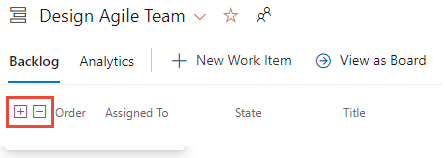
Backlog level selector
The number of backlog levels available to you are set by your team administrator and may have been customized to add custom work item types or backlog levels. Each backlog automatically applies the filters associated with the Area Paths and Iteration Paths selected for the team.
Note
Prior to using the tools described in this article, we recommend that you review Set up your project's backlogs and boards to ensure you have configured your backlog to support your team's needs.
From the Backlogs page, you can select the product backlog or a portfolio backlog. You select a backlog from the backlog level selector next to the ![]() View options icon. The labels within this selector vary depending on the process selected for your project, customization made to that process, and configurations made by your team administrator as shown in the following images.
View options icon. The labels within this selector vary depending on the process selected for your project, customization made to that process, and configurations made by your team administrator as shown in the following images.
Agile process
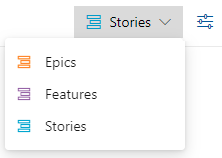
Scrum process
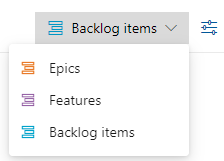
Basic process
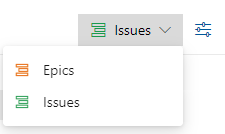
CMMI process
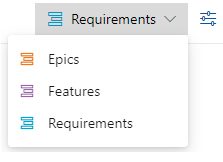
Customized process
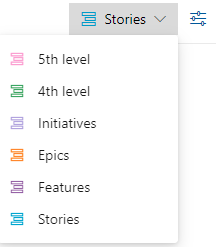
For information on team configuration of backlog levels, see Select backlog navigation levels for your team.
View options menu
The ![]() View options menu controls the following options.
View options menu controls the following options.
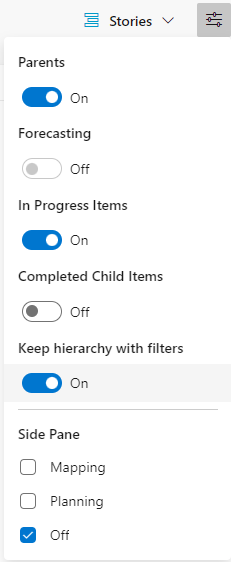
Parents: Show the hierarchical grouping of parent-child work items. Useful when adding child work items, reparenting a work item, or displaying rollup columns.
Forecasting: Show the Forecast tool and forecast lines. The Forecast option only appears for the first-level backlog and depends on the assignment of Story Points, Effort, or Size.
In Progress Items: Show items whose workflow State corresponds to an In Progress workflow state category. If you turn the In Progress control off, then items that are in the Active, Committed, or Resolved states or a custom workflow state defined in the In Progress state category won't appear in the backlog. For more information about category workflow states, see How to use workflow states and state categories.
Completed Child Items: Show child items that have been completed. Typically you turn this On when reviewing reviewing a rollup column.
Keep hierarchy with filters: Maintain the backlog hierarchy when filtering.
Mapping: Shows the Mapping pane to support drag-and-drop linking of work items to parent items. The Mapping option doesn't appear when you've selected the highest backlog level configured for your team.
Planning: Shows the Planning pane to support drag-and-drop of work items to Iteration Paths.
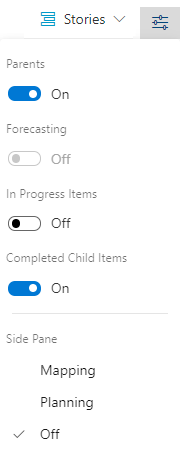
Parents: Show the hierarchical grouping of parent-child work items. Useful when adding child work items, reparenting a work item, or displaying rollup columns.
Forecasting: Show the Forecast tool and forecast lines. The Forecast option only appears for the first-level backlog and depends on the assignment of Story Points, Effort, or Size.
In Progress Items: Show items whose workflow State corresponds to an In Progress workflow state category. If you turn the In Progress control off, then items that are in the Active, Committed, or Resolved states or a custom workflow state defined in the In Progress state category won't appear in the backlog. For more information about category workflow states, see How to use workflow states and state categories.
Completed Child Items: Show child items that have been completed. Typically you turn this On when reviewing reviewing a rollup column.
Mapping: Shows the Mapping pane to support drag-and-drop linking of work items to parent items. The Mapping option doesn't appear when you've selected the highest backlog level configured for your team.
Planning: Shows the Planning pane to support drag-and-drop of work items to Iteration Paths.
Filter bar
Turn on filtering when you want to find one or more work items based on a keyword, tag, assignment, or other field you display using Column Options. You enable the filter feature by choosing ![]() Filter.
Filter.

Filtering displays a flat list of all items in the hierarchy when you have selected to show Parents. The hierarchical grouping is restored once you dismiss the filter toolbar. The filter toolbar persists until you dismiss it.
For more information, see Filter backlogs, boards, and plans.
Filter your backlog and maintain the hierarchy
You can filter your backlog and maintain the hierarchy of work by choosing show Parents and Keep hierarchy with filters from the View Options menu.
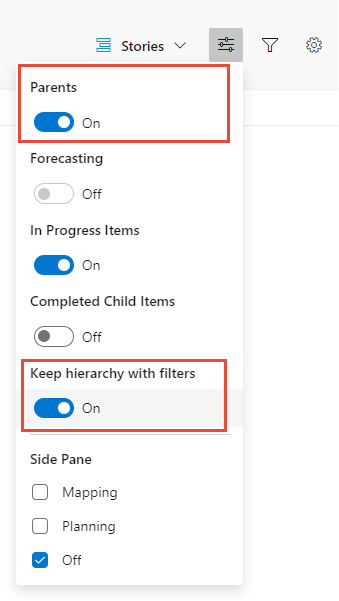
Use these options when you want to show work items assigned to one or more team members, work item types, area or iteration paths, or combination of these and keywords. The hierarchy is maintained and work items that match the filter criteria are shown in bold text.
Define backlog items
It's useful to be able to add work items quickly and refine details later when more information becomes available. Use queries on your backlog to triage, review, refine, and add details to work items that you entered through your backlog.
To quickly define many items to a backlog, perform the following steps.
Select the backlog level that you want to add items to.
From the View options menu, turn the slider for Parents and Forecasting to Off.
(Optional) turn In Progress Items on or off.
(Optional) Minimize the number of columns displayed on your backlog, or select those fields you want to view.
Choose
 New Work Item, enter a title, choose Add to top or Add to bottom, and then press Enter. We recommend you add items to the bottom of the backlog if your team has a process for prioritizing backlog items.
New Work Item, enter a title, choose Add to top or Add to bottom, and then press Enter. We recommend you add items to the bottom of the backlog if your team has a process for prioritizing backlog items.
Work items are automatically assigned the default Area Path and Iteration Path selected for the team.
Note
If you have Stakeholder access , you can only add work items to the bottom of the backlog. For more information, see Stakeholder access quick reference.
Continue entering a Title and pressing the Enter key to define more backlog work items.
For more information, see Create your product backlog and Define features and epics.
Prioritize your product backlog
If your team follows Agile or Scrum methods, they'll want to prioritize the backlog to make sure that the most important work to complete is situated at the top of the backlog. To prioritize a backlog, follow these steps.
Select the backlog level you want to prioritize.
Turn the Parents view option Off.
Drag the work items up or down within the backlog. Or, if you prefer to use the keyboard, hold down the Alt key and use the up and down arrows.

To reorder a backlog, you must have Basic or higher level access. If you have Stakeholder access, you can't reorder backlog items. For more information, see Stakeholder access quick reference.
Note
Changes you make to the priority impact all backlog items. When other team members refresh their backlog, they'll see the new priorities. A background process updates the Stack Rank (Agile, Basic, and CMMI processes) or Backlog Priority (Scrum process) fields. These fields are used by the system to track the relative ranking of items on the product, feature, epic, or other portfolio backlog. By default, these fields don't appear on the work item form. The priority ranking is assigned separately to each backlog level, which you can check by adding the field to a backlog and viewing a hierarchical list.
Backlogs that participate in portfolio management or that contain nested same-type child items might not allow you to reorder the items. For more information, see these articles:
- Backlogs, portfolios, and Agile project management, Work with multi-team ownership of backlog items
- Fix reordering and nesting issues
Prioritize a portfolio backlog
The method for prioritizing a portfolio backlog is similar to that described for a product backlog. The main difference is that you prioritize child items within each portfolio item. Each backlog level—Stories, Features, Epics—supports priority ordering distinct from every other level.
Prioritize the portfolio items:
- Select the portfolio backlog level you want to prioritize.
- Turn the Parents view option Off.
- Drag the work items up or down within the backlog.
- Within each item, you can expand to see child items and drag these items into priority order.
Prioritize child items:
- Expand each portfolio item.
- Drag each child item up or down within the expanded item.
Note
To reorder a backlog, you must have Basic or higher level access. If you have Stakeholder access, you can't reorder backlog items. For more information, see Stakeholder access quick reference.
Link work items to a parent (mapping)
You can drag items to quickly link one or several work items to a parent portfolio item.
Tip
Prior to opening mapping work items, add the portfolio backlog items you want to link work items to and prioritize them. The Mapping pane lists the portfolio backlog items in priority order.
Select the backlog level you want to link to parent items. For example, choose Stories to link to Features.
Open
 View options and choose Mapping.
The Mapping pane opens. By default, the pane lists the next-level up portfolio items for the current team.
View options and choose Mapping.
The Mapping pane opens. By default, the pane lists the next-level up portfolio items for the current team.(Optional) To map items to parent items owned by a different team, choose it from the team selector in the Mapping pane as shown in the following image.
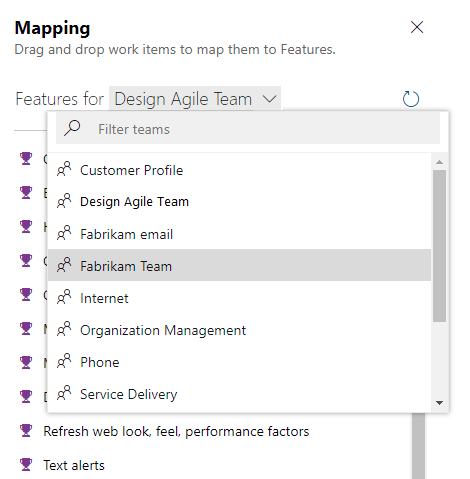
Drag work items from the backlog to the portfolio item listed in the Mapping pane. The system creates a parent-child link in the background. The backlog item turns bold and then unbold as the system saves the changes.
Note, you can select multiple backlog items and drag them to a portfolio item. To select several items in a sequence, hold down the shift key. To select several non-sequential items, use the Ctrl key. Then, you can drag the selected items.
(Optional) You can also drag a backlog item within the expanded hierarchical view to reparent a work item.
Tip
To view the work items that are unparented, you can add the Parent field as a column. The Title of the parent item is listed for those items that have been linked to a parent.
For more information, see Organize your backlog and map child work items to parents.
Add child items to a portfolio backlog item
Select the portfolio backlog level, such as Features, that you want to add items to.
Choose
 Add User Story, Bug for the feature you want to add the child item to as shown in the following image. Your labels may differ based on process and customizations.
Add User Story, Bug for the feature you want to add the child item to as shown in the following image. Your labels may differ based on process and customizations.In the work item form that appears, enter a Title and any other required fields or details. Save the work item to close it.
For more information, see Define features and epics, add child items.
View or find unparented work
To view or find unparented work:
- Select the backlog level you want to inspect for unparented items.
- Open View options and choose Parents.
- Scroll to the bottom of the backlog and expand Unparented Stories, Unparented Features, or similar entries. Unparented work items are listed under these entries.

Assign work to a sprint or iteration
Similar to using the Mapping pane, you can use the Planning pane to assign one or more work items to an Iteration Path or sprint.
Make sure all Iteration Paths have been selected for your team that you want to show in the Planning pane.
Choose the backlog level that contains the work items you want to assign.
Open View options, turn off Completed Child Items and choose Planning.
Drag work items from the backlog to the portfolio item listed in the Mapping pane. The system creates a parent-child link in the background. The backlog item turns bold and then unbold as the system saves the changes.
Note, you can select multiple backlog items and drag them to a portfolio item. To select several items in a sequence, hold down the shift key. To select several non-sequential items, use the Ctrl key. Then, you can drag the selected items.
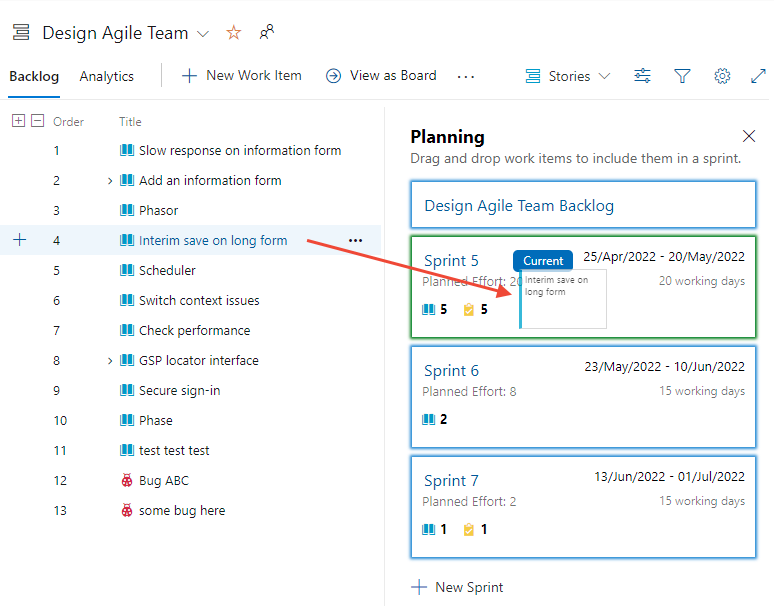
Forecast a backlog
The Forecast tool is only available for the product backlog. Use these steps to forecast your backlog. To use the Forecast tool, you must have Basic or higher level access. This feature isn't available to users granted Stakeholder access.
- Make sure that future Iteration Paths have been selected for your team.
- Choose the backlog level for your team.
- (Optional) Add the Story Points, Effort, or Size field as a column based on the process your project uses.
- Open View options and turn off Parents and In Progress items, and Completed Child Items. Turn on Forecast.
- Enter a velocity estimate in the Forecasting based on velocity of box.
- Review the forecast lines that appear, similar to the ones shown in the following image.
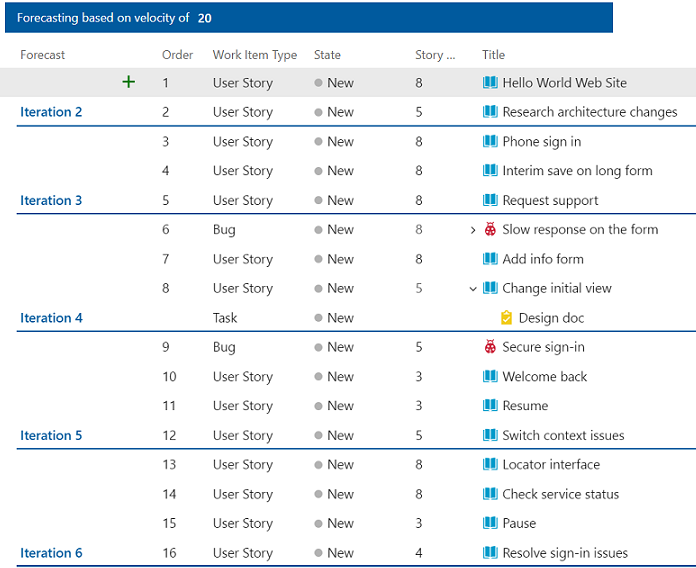 The forecast tool doesn't reference any iteration assignments made to the product backlog items.
The forecast tool doesn't reference any iteration assignments made to the product backlog items.
Tip
You can drag items to reprioritize them with forecast lines shown. You can also use the Planning pane with the Forecast tool turned on.
For more information, see Forecast your product backlog.
Review progress made to your backlog
You can add a rollup progress bar, count of work items, or sum of any integer or numeric field as a column to the backlog. This option allows you to review progress made to parent work items based on the completion of their child items. These child items can be Tasks for User Stories, User Stories and Bugs for Features, or Features for Epics.
Select the backlog level you want to view progress on
Open View options, show Completed Child Items
Open Column Options, choose Add a rollup column, and select the progress bar or count to display.

It can take several moments for the progress bar or count to appear.
For more information, see Display rollup progress or totals.
Related articles
- Set up your project's backlogs and boards
- Create your product backlog
- Define features and epics
- Organize your backlog and map child work items to parents
- Configure team settings